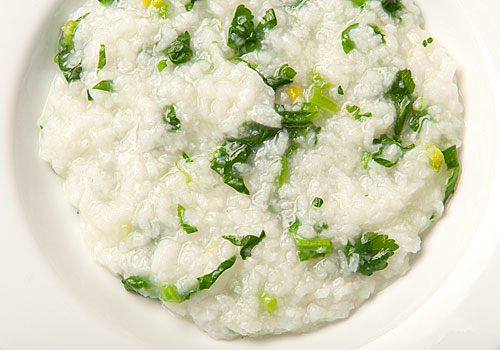
The more I study old Japanese customs, the more I am impressed by the logical thinking behind many of them, even when examined with modern eyes. One of these the custom of partaking of a bowl of nanakusagayu on the seventh day of the New Year, which supposedly started in the Heian Period (around the 12th century), in the refined court of Kyoto. Nanakusa means seven greens, and kayu (or to use the honorific term, okayu (お粥)), is rice porridge. The Imperial Court, now in Tokyo, still has a nanakusagayu ceremony on the morning of January 7th.
Filed under:
japanese lighter rice vegetarian vegan

It's been a cold and snowy winter so far around these parts, which usually means soups and stews for dinner. This classic Japanese soup is hearty yet low in calories, full of fiber, and just all around good for you. It helps to counteract all the cookies and sweets you might be indulging in at this time of year.
The name kenchinjiru (けんちん汁)derives from the Zen Buddhist temple where it was first made (or so it's claimed), Kencho-ji (建長寺)in Kamakura. (Kamakura (鎌倉) was, for a brief while, the capital of Japan in the 12th and 13th centuries. Nowadays it's a major historical tourist attraction, and a fairly easy day trip from central Tokyo.) Since kenchinjiru is a shojin ryouri or temple cuisine dish, the basic version given here is vegan. It's still very filling because of all the high fiber vegetables used. You could make a very satisfying vegan meal just from this soup and some brown rice.
Filed under:
japanese lighter soup winter vegetarian favorites vegan washoku shojin

(Note: Your responses to the question posed below may be translated for a Japanese blog! Read on...)
Even though I'm Japanese, I do think that we eat an awful lot of food that could be considered to be odd. One of them is the infamous fugu, or puffer fish. Fugu's main claim to fame, besides its extraordinary appearance (it puffs itself up to make itself look a lot bigger to predators), is that its skin and organs are highly poisonous. Nevertheless, it's considered to be a great delicacy in Japan. It's now fugu season in fact, so many people are tucking in to fugu sashi (fugu sashimi), fugu nabe (fugu hotpot), and so on.
Filed under:
japanese fish offbeat japan
Submitted by maki on 23 October, 2009 - 10:58
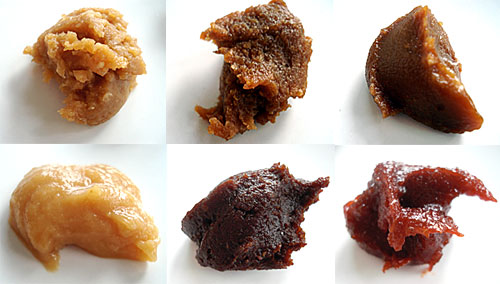
[From the archives. This miso primer was published here last September (2008). I've added some notes about miso-based blends, especially sumiso or miso with vinegar.]
This is a post that has been a long time coming. I kept on holding it off until I had a good variety of miso on hand to show photos of. I can't say I have a comprehensive selection to show you, but I hope you will find this article useful anyway.
Miso (味噌、みそ), as you probably know already, is a naturally fermented paste made by combining cooked soy beans, salt, and often some other ingredient such as white or brown rice, barley, and so on. The texture can range from smooth to chunky, and the color from a light yellow-brown to reddish brown to dark chocolate brown, and the flavor ranges from mildly salty and sweet to strong and very salty. It is packed with umami and protein, not to mention all sorts of nutrients.
Miso-like fermented bean products and pastes exist all over Asia, but here I will mainly limit myself to the most commonly used Japanese misos.
Type:
feature Filed under:
basics japanese ingredients miso
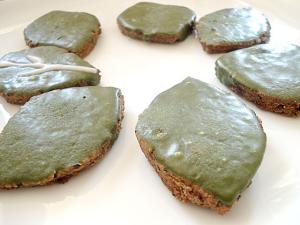
[From the archives. These sesame cookies with matcha icing look and taste quite dramatic. In leaf shapes they are rather spring-like, but try simple rounds or squares for year-round appeal. Originally published in April 2007.]
Flavor wise black sesame seeds aren't that different, if at all, from white or brown sesame seeds. But there is something about their dramatic black-to-grey color that is quite exciting. At the moment I'm quite enamored with black sesame seeds, and have been using them instead of the regular brown ones in everything from sauces to salads.
These leaf shaped cookies contain toasted and ground black sesame seeds, dark brown muscovado sugar, and whole wheat flour, and are decorated with matcha (powdered tea) royal icing. The sweetness is quite restrained, both in the cookie and in the icing. You are first hit by the tea-flavored, very slightly bitter icing, followed by the nutty darkness of the cookie. It's an intriguing combination. They are a wonderful accompaniment to tea, black or green, hot or iced. If the ultimate cookie to you means something very sweet and gooey you may not like these. They are quite adult cookies.
I had to shoot the pictures in a hurry, because they were disappearing faster than almost any other cookie I've made recently.
Since I don't have a leaf shaped cookie cutter, I just made a simple paper template and cut the leaves out with a knife. You can cut them out into any shape you'd like of course, though given the coloring leaves seem appropriate. Quite spring-like, in fact.
Filed under:
dessert japanese baking cookies favorites tea
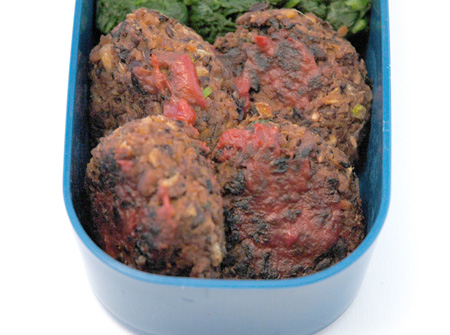
__From the archives. This is terrific freshy made and hot, but is even better cold, so it's great for bentos. Originally published in November 2007.__
Over the past couple of years as I've pursued
largely vegetarian eating, I've gradually accumulated a small arsenal of small, round bean patties or balls, which are great as snacks, for bento boxes, and just for dinner, in my regular rotation. This one was inspired by one of the first beany-round thing I made,
the samosa-like lentil snacks from
The Hungry Tiger, and a Japanese vegan cooking book called
_Saisai Gohan_ (Vegetable Meals) by Yumiko Kano. (Yumiko Kano is currently my favorite cookbook author in any language, and I'll talk more about her down the line.) I've adjusted a few things to make them gluten-free.
These have the earthy, deep flavor of the black beans that is enhanced by the spices and the sauce, and they are delicious hot or at room temperature. Even diehard carnivores like them. They're really perfect for bento lunches, and I've used it in the all-vegan
Bento no. 5 on Just Bento. I also used them as a pita-sandwich filling in
Bento no. 6.
I have described two methods of cooking these: in the oven, which is good for making them in quantity, and in a frying pan, which is perfect for making a few at a time.
Filed under:
japanese lighter legumes vegetarian vegan
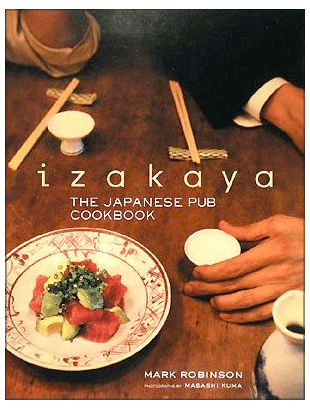 When a Japanese person dreams of quitting his or her rat-race job and opening a restaurant, the type of restaurant they usually envision is either a kissaten or kafe (a café-restaurant) or an izakaya. An Izakaya (居酒屋)is a small traditional pub that serves food, rather like a Spanish tapas bar. Many are quite tiny, with just the counter and maybe a few tables. The best ones are run with a lot of passion and love, and have fiercely loyal customers.
When a Japanese person dreams of quitting his or her rat-race job and opening a restaurant, the type of restaurant they usually envision is either a kissaten or kafe (a café-restaurant) or an izakaya. An Izakaya (居酒屋)is a small traditional pub that serves food, rather like a Spanish tapas bar. Many are quite tiny, with just the counter and maybe a few tables. The best ones are run with a lot of passion and love, and have fiercely loyal customers.
Izakaya, the Japanese Pub Cookbook conveys the atmosphere and love of food and good sake that are hallmarks of good izakaya perfectly. Written by Mark Robinson, an Australian journalist who fell in love with izakaya establishments in Tokyo, with gorgeous photography in both color and black and white by Masashi Kuma, it is part cookbook and part ode to the cult of the izakaya. You don't just get recipes here, even though it's called a cookbook. There are profiles of izakaya masters, useful advice on izakaya etiquette, notes on sake types, anecdotes and a lot more. I think it can reside as happily on a bedside table as in the kitchen - a quality I look for when I buy cookbooks.
Filed under:
books and media japanese washoku
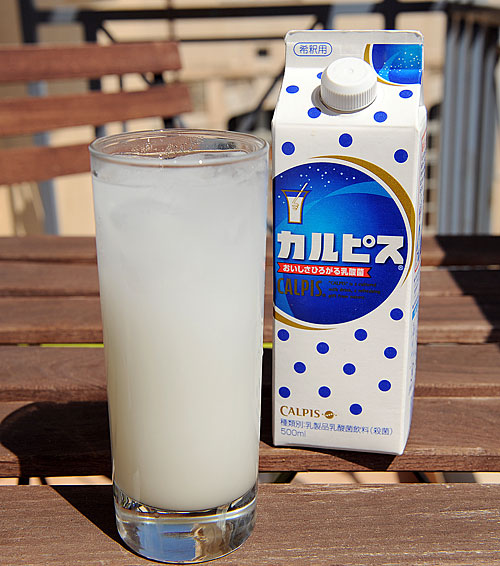
As your sometime guide to Japanese culinary culture, I would be remiss if I let another summer pass by without talking about Calpis.
Calpis is a sweetened fermented milk beverage. The label says:
"CALPIS" is a cultured milk drink, a refreshing gift from nature.
People tend to either love or hate Calpis.
Filed under:
drink essays japanese summer memories
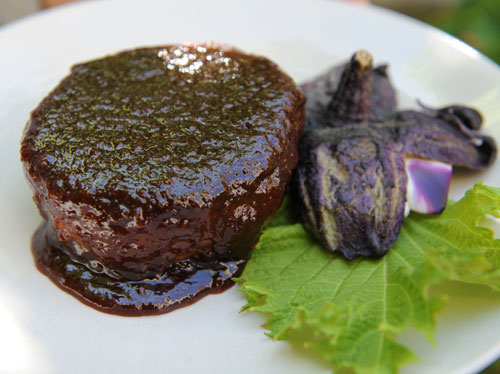
It's still summertime, but I can feel the cooler days of fall coming, especially in the evenings when the temperature is dropping just a bit more than it did a few weeks ago. This is one of the best times of the year for food lovers, especially if you love vegetables.
Eggplants (aubergines) are in high season now and will be around for at least another month or so. While you can get them year-round, they are at their best of course in their natural season.
This is a classic Japanese way of serving eggplant, and it's really easy. All you do is to slowly roast the eggplant until tender, either in the oven or on the stovetop in a frying pan, then serve with a glossy, salty-sweet dengaku (田楽)sauce. I could eat this every day, with a bowl of plain rice and some cold mugicha to wash it down.
Filed under:
japanese vegetables fall vegetarian summer vegan eggplant
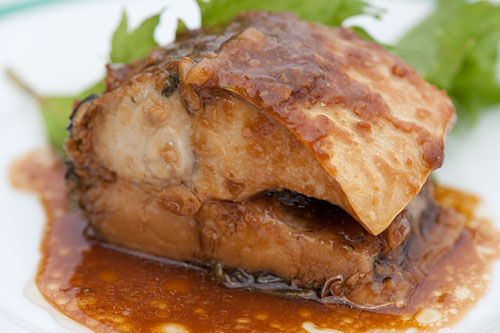
Here's another classic Japanese recipe from my mother. I have to admit that I'm not very good with fish, with the exception of simple grilling or panfrying and so on, but my mom has all kinds of great fish recipes up her sleeve.
Last week we spent a rather chilly week in Brittany (Bretagne), where the highlight was definitely the abundance of cheap, really fresh fish available to us. One fish in particular that was really good and inexpensive was maquereau, or Atlantic mackerel, which we know as saba (鯖 さば)in Japanese. In Japan, mackerel is usually treated one of three ways: grilled over an open flame (amiyaki), treated with salt and vinegar (shimesaba) and turned into an old fashioned kind of sushi (sabazushi), or gently braised in a sauce with the classic Japanese combination of salty-sweet flavors. This mackerel is cooked in a ginger scented miso sauce, then allowed to cool down in the liquid overnight, which allows the flavors to penetrate the firm flesh of the fish. You barely notice the oiliness at all, and the sauce is plate-lickingly tasty. I like to eat it chilled, right out of the refrigerator, with plain rice and a simple salad on the side. It makes for a refreshing yet rich dish for a summer meal.
Filed under:
japanese fish seafood
Pages